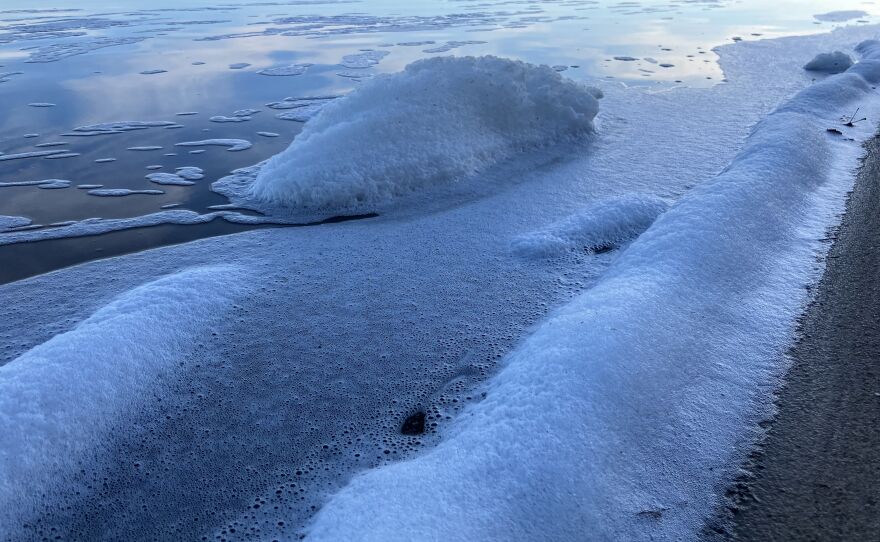Foam on lakeshores is often a natural occurrence, usually caused by dying aquatic plants or algae that’s stirred up by waves.
Natural foam is usually off-white and has an earthy smell, but some foam — that’s artificially white — contains toxic “forever chemicals.”
Cathy Wusterbarth said she never remembers seeing foam in her hometown when she was growing up in Oscoda.
“Even when I was a lifeguard on Van Etten Lake, there wasn't visible foam from what I recall, and when I asked others, they don't remember seeing it either,” she said.
But now, Wusterbarth notices it all the time. She points out little specks of foam on Lake Huron, that she suspects contain PFAS chemicals.
“See the bubbles? That’s all PFAS foam," Wusterbarth said. "It’s like everywhere.”
After Wusterbarth learned about contamination from the former Wurtsmith Air Force Base, she founded the group, Need Our Water, to advocate for more cleanup measures in her community and raise awareness about PFAS.
The foam is something she can’t ignore. Sometimes, it washes up on Oscoda’s beaches in huge, billowy white piles.
“The more I learned about how toxic PFAS is, I realized that it's probably not safe to swim in (Van Etten) lake," Wusterbarth said. "And I just wanted to learn more about how to protect my community, myself and my family.”

“It's one of the more visible reminders that PFAS is in our environment,” said Kevin Cox, a toxicologist with the Michigan Department of Environment, Great Lakes and Energy.
Cox said it’s still a mystery why PFAS foam forms on waterbodies in the first place.
“Foam also disappears pretty quickly, too, so there's a challenge in going out and assessing that foam," Cox said. "The concentration of PFAS may not be the same as the next time you go out there and sample that same location.”
PFAS levels in foam are typically much higher than the contaminant levels in the greater surface water like a river or lake.
The state does have regulatory limits on PFAS levels in drinking water and surface waters, but there are no standards for the chemicals in foam.
“The likelihood of somebody having very prolonged contact with foam is much less compared to where we're seeing with fish consumption or concerns of exposure to surface water during recreational activity," Cox said. "So that makes it lower on our priority to do any type of assessment (for foam).”
Cox said reporting foam sightings still helps the state identify sources of PFAS contamination.
“Eventually when we reduce levels going into the environment, we’re going to see reductions in that foam occurrence,” he said.
Public health officials report the health risks from PFAS foam are low. The state defines prolonged contact as three hours a day, five days a week and three months of a year.
Marcus Wasilevich, with the Michigan Department of Health and Human Services, said touching the foam is not a major health concern, especially compared to consuming contaminated water or fish.
“Know your sources of exposure," Wasilevich said. "Right now, the main concern is ingestion and swallowing PFAS.”
Just to play it safe, he advises to avoid touching any and all foam, and if people come into contact, he said rinsing off will do the trick.
“It may have PFAS in it, it may have other things in it, including biological organisms like bacteria or fungus," Wasilevich said. "So in general, avoid foam if you see it, but don’t let it scare you from recreating in our waters.”
For Cathy Wusterbarth, the foam is just the “tip of the iceberg” when it comes to contamination in her community.
“It just sickens me," Wusterbarth said. "I equate (PFAS contamination) to like a tumor on our earth. It's a tumor, and it's spreading.”
Wusterbarth sampled foam on the town's Lake Huron shoreline, with help from the environmental nonprofit, the Ecology Center. The recent report confirmed high levels of PFAS chemicals.
Without standards for foam, there’s no prescribed follow-up. But Wusterbarth said education is essential in reducing the public’s exposure to the toxic chemicals.
She’d like to see more expanded testing in the Great Lakes and signage that warns beachgoers of foam and its risks.
“It concerns me that people don't know what the risks are of their animals touching it, their kids touching it their mouth," Wusterbarth said. "For very highly contaminated (and concentrated) PFAS foam, that's dangerous.”












![Kevin Cox [left] and Mike McCauley [right] slice brook trout into filets as part of the state fish contaminant monitoring program April 21 at an EGLE facility in Lansing.](https://npr.brightspotcdn.com/dims4/default/3734542/2147483647/strip/true/crop/5603x3122+0+307/resize/280x156!/quality/90/?url=http%3A%2F%2Fnpr-brightspot.s3.amazonaws.com%2Ffb%2F2d%2F72e0a6f44220bda9335a589e3785%2Fmicrosoftteams-image-3.png)
